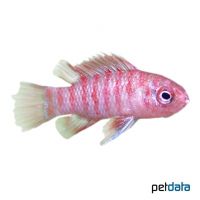Scarlet Badis (Dario dario)
| Scarlet Badis Dario dario | |
|---|---|
| Name | Scarlet Badis |
| Name Lat. | Dario dario |
| Synonym | Badis dario |
| Family | Chameleonfishes |
| Family lat. | Badidae |
| Order | Labyrinth Fishes |
| Order lat. | Anabantiformes |
| Origin | NO-India |
| Habitat | Streams |
| Diet | Carnivore |
| pH | 6.0-7.5 |
| Behavior | ♂ territorial |
| Keeping | Pair, harem |
| Care Level | Difficult |
| Reproduction | Substrate spawner |
| Breeding | Difficult |
| Life Span | 2-3 years |
| Protection | No |
| Metric Units | |
| Size | 2.5 cm |
| Temperature | 18-26 °C |
| Hardness | 3-15 °dH |
| Aquarium | ~ 60 l |
| US Units | |
| Size | 1" |
| Temperature | 64-79 °F |
| Hardness | 53-267 ppm |
| Aquarium | ~ 15 gal |
Distribution and habitat
The distribution area of the Scarlet Bluefish is the Brahmaputra river system in western Assam and neighboring West Bengal. There they live in clear, slow-flowing streams and small rivers with partly dense underwater vegetation.
Maintenance
The aquarium should have a dense border planting, with many hiding places, such as roots, stone caves or bamboo tubes and offer free swimming space. A dark substrate of sand and fine gravel covered with some foliage (e.g. sea almond tree, oak), subdued light (floating plants) and soft, slightly acidic, oxygen-rich water is ideal.
No ammonia, ammonium and nitrite should be detectable, and the nitrate value should not exceed 100 mg/l. To ensure the water quality and oxygen content, a filter and heater adapted to the aquarium size is required, as well as lighting for the species-appropriate day-night rhythm of the animals.
Diet
The food supply consists of live, frozen and dry food. For a balanced diet, feed once daily with plankton, cyclops, daphnia, moina and artemia (live or frozen). After habituation, dry food is also accepted, but should not be the main component of the diet. It is recommended to feed small portions several times a day. Only feed as much as will be eaten within a few minutes. A regular and varied diet promotes health and increases resistance.
Behaviour and compatibility
They should be kept in pairs or in a harem, one male with several females. The males of these shy and quite peaceful fish form small territories, which are consistently defended within the species. Keeping several pairs or harems is only recommended in a larger and richly structured tank. They should only be socialized with other small and not too lively fish, but it is better to keep them in a species tank.
Basically, only compatible fish species with similar demands on water quality and water temperature may be socialized.
Sex dimorphism
The male is more colorful and easily recognized by its inward curved (concave) ventral line. The females are smaller and not so intensely colored.
Reproduction and breeding
They are substrate spawners and prefer to attach the spawn to fine feathery plants or moss. The larvae hatch after 2-3 days and swim freely after about 5 days. No brood care is practiced.
Fry must be fed several times a day with special rearing food (infusoria, Artemia nauplii). In a community tank breeding is hardly possible, because the young fish are easy prey.
Important
Dario dario are among the smallest known perch fish
The foliage (sea almond tree, oak, etc.) enriches the water with humic substances, naturally lowers the pH and is a valuable secondary food source.
The well-being of the fish should be monitored regularly. Temperature should be checked daily, pH, hardness and nitrate levels should be checked at least every 14 days. Regular partial water changes are recommended, even when contaminant levels have not yet reached the upper limit. Sudden changes in water quality should be avoided. Newly introduced fish must be accustomed slowly to the water in the aquarium.
Further literature can be found in your pet store.
References
Text: petdata; Image: petdata
Source: BMEL (1998): Tierschutzgutachten - Haltung von Zierfischen (Süßwasser); BAENSCH & EVERS (2004): Aquarien Atlas Bd. 6, Mergus Verlag; ENGELMANN (2005): Zootierhaltung - Tiere in menschlicher Obhut: Fische, Verlag Harri Deutsch
- Gemäß § 21 Abs. 5 Tierschutzgesetz idgF
